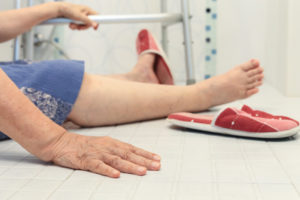5 Ways to Minimize Falls in Senior Care Facilities
 In the United States, one in four people aged 65 and over has a fall every year — and, sadly, an older adult dies from a fall every 19 minutes. Falls are a leading cause of fatal injury for older adults, and the financial toll is expected to increase and may reach as high as $67.7 billion in 2020.
In the United States, one in four people aged 65 and over has a fall every year — and, sadly, an older adult dies from a fall every 19 minutes. Falls are a leading cause of fatal injury for older adults, and the financial toll is expected to increase and may reach as high as $67.7 billion in 2020.
Fall prevention is essential not just because it helps to prevent injuries, but because it helps people maintain independence as the body ages.
Factors that cause falls in senior care facilities include muscle weakness, medications that inhibit balance and coordination, gait balance deficit, impaired vision and hearing, change in the environment, and many others. So, what can you do to reduce falls in senior care facilities? Here are five strategies:
1. Encourage seniors to eat healthy foods and be active
Seniors are vulnerable to falls, in part, because their bodies are weak. Make sure your residents are eating healthy foods that are rich in essential nutrients and minerals. Nutritionists recommend foods that are rich in vitamin D and calcium to help strengthen bones. It is also essential to drink plenty of water.
Apart from eating healthy foods, seniors’ general state of fitness is also critical. Most of the seniors who fall in senior care facilities don’t exercise regularly. Physical activity helps strengthen bones and muscles.
Heavy physical activity is not necessary, but regular activity is important. Seniors who are capable should use stairs instead of an elevator and walk whenever possible.
2. Install handrails, grab bars, and adequate lighting
Handrails and grab bars can help reduce the chance of falls among the elderly. They should be installed on stairways, corridors, around toilets, and elsewhere as needed.
Inadequate lighting is also another major contributor to falls among seniors. To prevent falls, brighter light bulbs should be installed, particularly in narrow hallways and stairways. Nightlights should be installed in bathrooms and bedrooms to enhance visibility at night.
3. Keep up on vision checks
Impaired vision is one of the leading causes of falls among the elderly, so seniors’ vision should be checked regularly by an eye professional. Glasses prescriptions should be updated as needed.
4. Encourage proper footwear
Good shoes and sturdy slippers can help prevent falls. Floppy slippers, high heels, and shoes without good grip can easily lead to slips and falls. Well-fitting shoes also help prevent joint pain, which can also contribute to slips and falls.
5. Watch out for problematic meds
Many medications can cause dizziness, fatigue, headaches, and even hallucinations, all of which can create a higher risk of unsteadiness and falls. And the more different medications a person takes, the higher the likelihood of drug interactions.
The bottom line is that a comprehensive fall prevention plan is vital to keeping your seniors active, independent, and healthy.

Karen Smith has been working for MePACs as the Head of Sales and Marketing for the last four years and has over 20 years’ experience in health, technology, digital, and finance industries.
Related Articles
Topics: Featured Articles , Rehabilitation , Resident Care , Risk Management , Senior Environments











